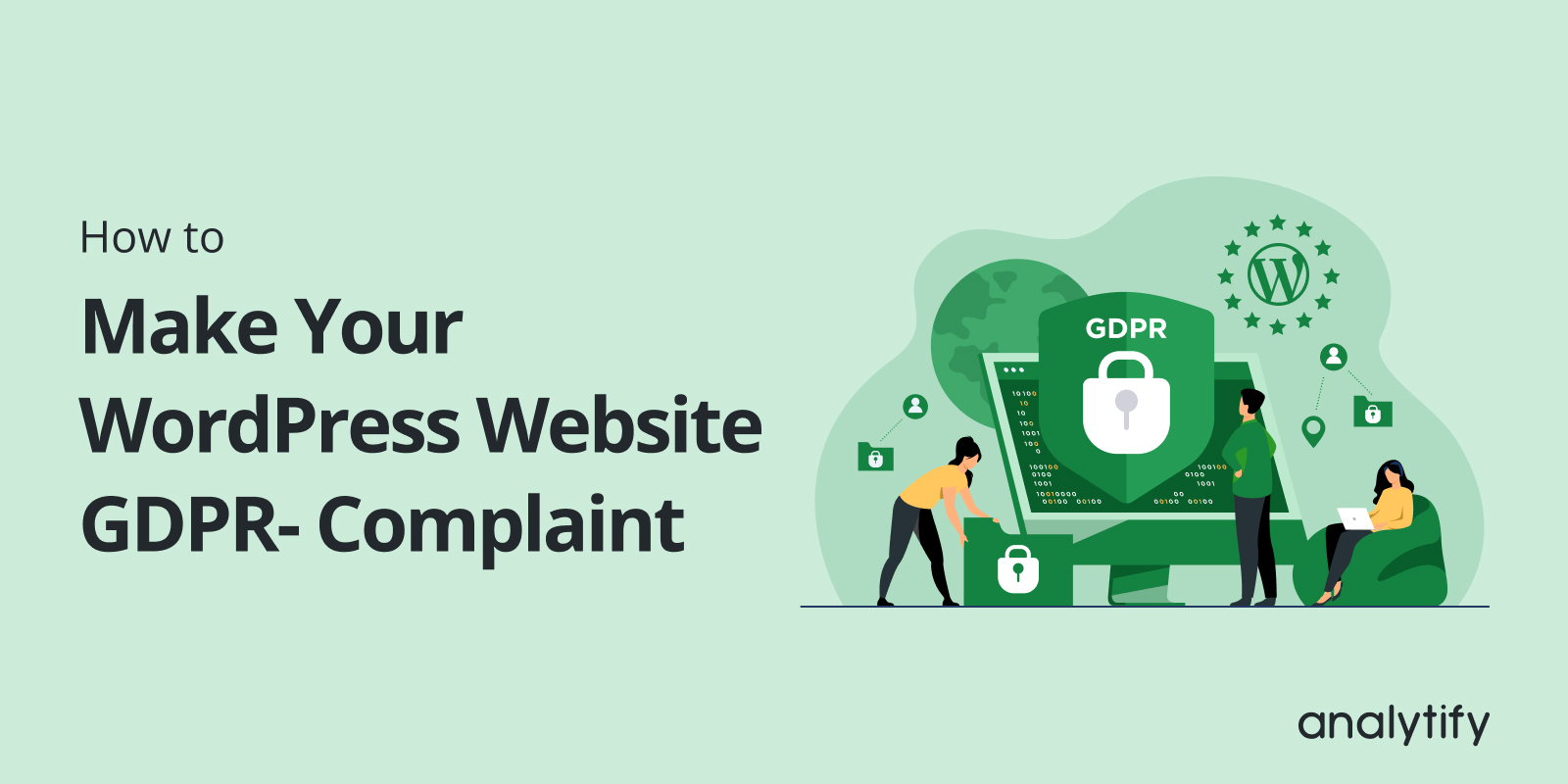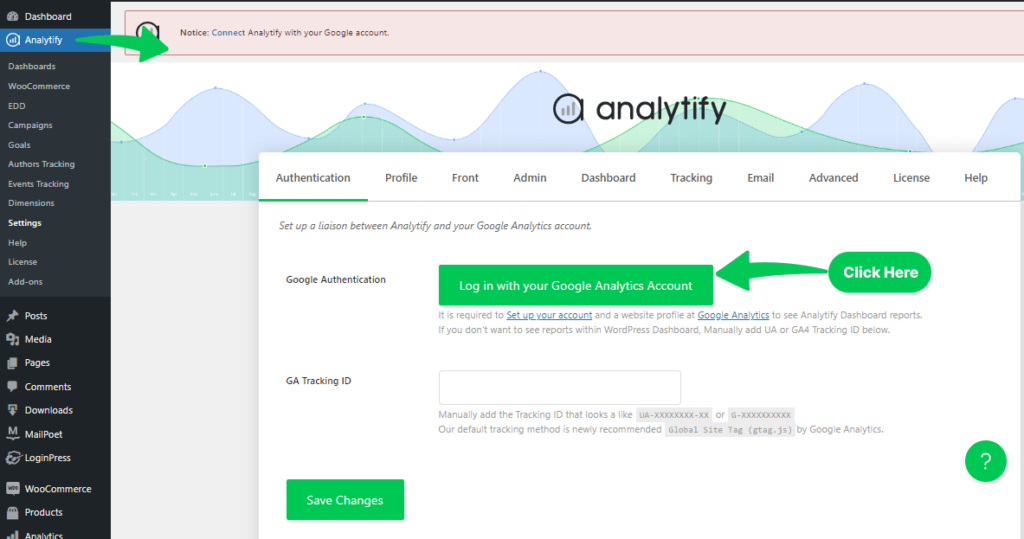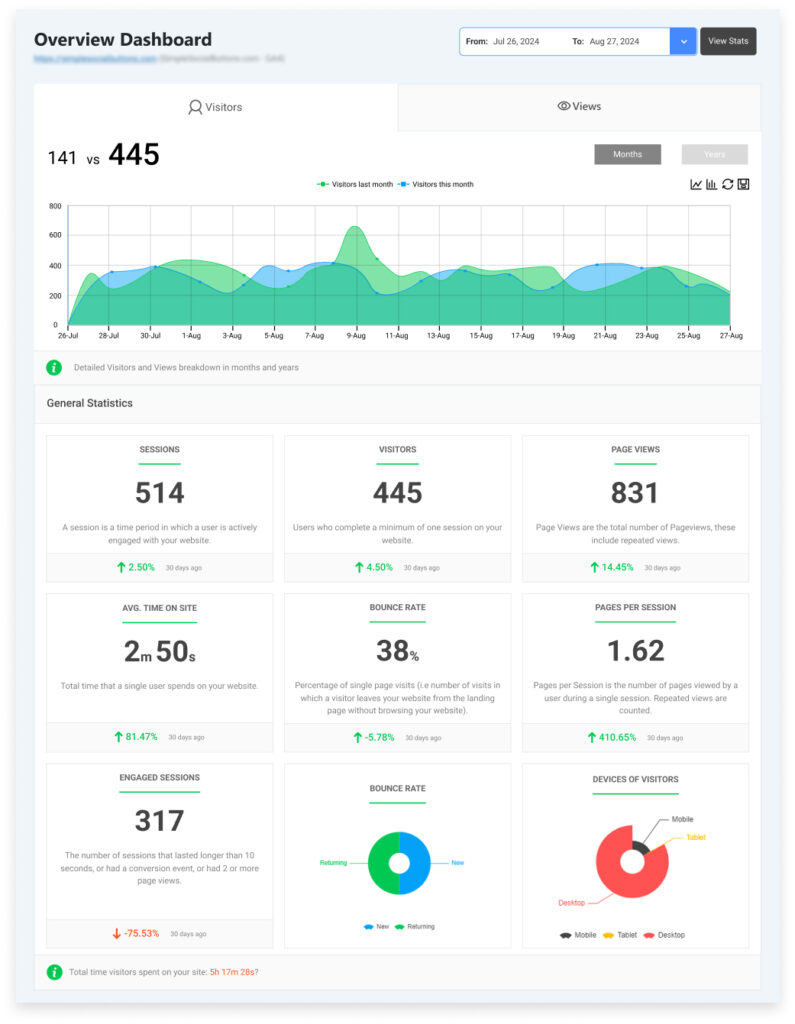
How to Make Your WordPress Website GDPR-Compliant (2026)
Do you want to know how to make WordPress website GDPR-compliant?
There are few regulations as globally impactful for online businesses as the GDPR. But what is the GDPR, exactly? Simply put, it’s an incredibly important regulation that protects all citizens who live and work in the European Union (EU). Ensuring GDPR compliance for WordPress websites is important for protecting user data and avoiding hefty fines.
However, Europe’s General Data Protection Regulation isn’t just looming over businesses in Berlin, Brussels, and Barcelona. It’s also quietly eyeing your WordPress site from across the Atlantic, wondering what you’re doing with all that juicy user data from your business headquarters in San Diego.
Here’s the catch: if your website collects data from anyone in the EU–even if it’s just one person who signs up for your newsletter or buys a t-shirt–you’re expected to comply with GDPR. This isn’t one of those “Oh, we’ll worry about it when we go global” problems. If you’re capturing names, emails, IP addresses, or anything else that identifies a person, you’re in GDPR territory whether you like it or not.
And what happens if you ignore it? Think less “slap on the wrist” and more “multi-million euro fine.” But even scarier than the regulators? Your users. Today’s Internet-savvy public doesn’t take kindly to privacy oversteps. You don’t want to be that brand featured in a takedown on X or Instagram.
In this guide, we’ll walk through exactly how to make your WordPress site GDPR-compliant step by step. From technical must-dos (like cookie banners and privacy policies) to legal structure basics, you’ll learn how to launch, grow, and protect your business without inviting legal drama.
GDPR Compliance for WordPress (TOC):
What GDPR Requires
GDPR is about protecting individuals’ personal data and giving them control over how it’s collected, stored, and used. If your WordPress website touches the data of even one EU resident–yes, even through a contact form–you’re expected to comply. Here’s what that means in practice:
Key GDPR principles:
- Lawful, fair, and transparent data processing: You must have a valid reason for collecting data and be upfront about what you’re doing with it. No hidden agendas.
- Purpose limitation: Only collect data for specific, legitimate reasons, and don’t use it later for something completely unrelated.
- Data minimization: Don’t collect more data than you need. If an email address is all that’s required, skip the full birthdate, phone number, and address.
- Accuracy and timely updates: Make sure the data you store is correct and give users a way to update it.
- Storage limitation: Don’t hold on to personal data forever. Only keep it as long as necessary.
- Integrity and confidentiality: Secure the data you collect. This includes using encryption, HTTPS, and proper access controls.
User rights under GDPR include:
- Right to access: Users can ask what personal data you’ve collected about them.
- Right to rectify: They can correct inaccurate or incomplete data.
- Right to delete: Also known as the “right to be forgotten,” users can request that their data be erased.
- Right to data portability: Users can ask for their data in a format they can take elsewhere.
- Right to object: They can say no to certain types of processing, like direct marketing.
- Right to withdraw consent: If someone gave you permission to use their data, they can take it back at any time.
Understanding these principles enables you to have GDPR compliance for WordPress and shows you are committed to running a good business. Plus, it builds trust and gives users confidence in your brand.
Common WordPress GDPR Violations & How to Avoid Them
WordPress makes it easy to spin up a website, but it’s just as easy to fall into GDPR trouble if you’re not careful. Here are some of the most common GDPR compliance missteps and how to sidestep them.
One major issue? Cookies. Many sites track users through cookies for analytics, ads, or embedded content but fail to disclose it properly. Under GDPR privacy policy for WordPress, you must inform users and get explicit consent before dropping non-essential cookies.
Another frequent slip-up is using contact forms that don’t explain how the submitted data will be used or stored. Every form should have a brief notice, such as a link to your privacy policy, outlining what happens to user information.
Watch out for these pitfalls as well:
- Failing to respond to or honor data access or deletion requests.
- Integrating third-party tools (like analytics or marketing plugins) without verifying they’re GDPR-compliant.
- Collecting data without a clear legal basis or consent.
Make sure your business implements these best practices as part of your everyday operational practices.
How to Make WordPress Website GDPR-Compliant (Step by Step)
Getting compliant requires following a series of smart, manageable steps and ensuring you stay on top of needed updates or changing requirements. Here is some advice on how to build your website as per the GDPR privacy policy for WordPress.
1. Update Your Privacy Policy
Your GDPR privacy policy for WordPress isn’t just legal boilerplate or copy and paste verbiage. Rather, it’s the front line of transparency with your users. GDPR requires you to be upfront about your data practices.
What to include:
- What data you collect (name, email, IP address, etc.)
- Why you collect it (e.g., contact, analytics, marketing)
- How long you store it
- Who you share it with (think third-party plugins or email services)
- How users can access, correct, or delete their data
2. Add a Cookie Consent Banner
If your site drops cookies (and an FYI, it probably does), users need to opt in, not just be notified.
Use WordPress GDPR plugins like:
- CookieYes
- Complianz
- GDPR Cookie Consent
Customize settings by region: GDPR for EU visitors, CCPA options for California users (we’ll discuss this later).
3. Set Up Consent Management for Forms
Forms are a major source of personal data. Therefore, make sure consent is baked in.
For contact forms (e.g., WPForms, Contact Form 7):
- Add clear checkboxes stating users agree to your terms
- Make sure consent is not pre-checked
- Store records of the consent given
4. Secure Your Data
Data protection isn’t just about policies. Instead approach it through the lens of working to keep information out of the hands of bad actors.
Best practices:
- Install SSL and enforce HTTPS sitewide
- Use strong, unique passwords and limit user roles
- Keep plugins/themes updated to patch vulnerabilities
- Back up regularly and consider database encryption
5. Create a Data Access & Deletion Process
Under GDPR, users can ask what data you’ve got. They also have the right to demand that you delete it.
How to handle it:
- Use plugins like WP GDPR Compliance or GDPR Data Request Form
- Set up a manual or automated way to log requests and confirm deletions
- Maintain an audit trail of who requested what, when, and what you did
6. Check Your Plugins and Third-Party Tools
If a plugin collects data, you’re on the hook for what it does with that data.
Audit your stack:
- Google Analytics
- Mailchimp
- Stripe
- Facebook Pixel
For each one, check that it:
- Has a clear privacy policy
- Publicly states GDPR compliance
- Offers a Data Processing Agreement (DPA) if needed
7. Email Marketing Compliance
Your email list can be a legal minefield if you’re not careful, so tread wisely.
Checklist:
- Use double opt-in to confirm subscriptions
- Include an unsubscribe link in every email
- Store time-stamped proof of consent
Business Structure & Legal Basics That Help
Launching your WordPress site as a solo project under your own name might seem like the fastest and most straightforward route. However, know that it’s not always the smartest.
If your site collects personal data (as almost every modern site does), you’re potentially exposing your personal assets to risk. A data breach, a privacy violation, or even a dispute with a vendor could land you in legal trouble, and if you’re operating as a sole proprietor, that liability hits your wallet directly.
That’s where forming a Limited Liability Company (LLC) comes in. Whether you’re in Texas, Florida, or anywhere else in the U.S., an LLC separates your personal finances from your business obligations. This means:
- Limited liability protection if things go sideways.
- Credibility when setting up accounts with vendors or payment processors.
- Structure for handling data compliance contracts and user agreements.
If you’re operating in California, be aware of the specific requirements to form an LLC in California, which include filing Articles of Organization, appointing a registered agent, and submitting a Statement of Information within 90 days.
You’ll also need a few legal and operational essentials:
- EIN (Employer Identification Number) from the IRS
- Needed to open a business bank account.
- Required to enter into vendor and affiliate contracts.
- Often necessary to integrate payment systems like Square, Stripe, or PayPal Business.
- Registered agent
- This is a designated person or service that can receive official documents (like legal notices or government forms) on your behalf.
Structuring your site like a business from day one helps you scale smart while remaining protected. And that’s just good for your mental health and peace of mind–both short and long-term.
Extra GDPR Tools for WordPress Users
Once you’ve tackled the basics of GDPR compliance for WordPress, it’s wise to go a step further with specialized GDPR tools to help automate, document, and monitor your privacy practices. These plugins and services can save time, reduce manual errors, and show regulators–as well as users–that you take data protection seriously.
Audit and monitoring tools
Keeping track of who’s doing what on your WordPress site is critical for both security and accountability.
- WP GDPR Compliance helps integrate consent features with popular plugins.
- WP Activity Log keeps a detailed log of user activity, which is useful for tracking access to personal data.
Consent and log management
Since you need to collect and record consent, these WordPress GDPR plugins streamline the process:
- Termly offers customizable consent banners, policy templates, and keeps logs.
- iubenda handles legal documentation and consent logging for multiple jurisdictions.
Privacy policy generators
These tools create professional policies and update them automatically when regulations change. Both Termly and iubenda offer this functionality, making it easier to stay compliant over time without chasing down new legal language.
Other Legal Frameworks That Might Apply
GDPR isn’t the only regulation you need to think about, especially if your WordPress site reaches beyond the EU or handles sensitive data based on the industry you operate in.
Depending on your users, your content, or the type of information you collect, several other legal frameworks may also apply.
- CCPA/CPRA (California Consumer Privacy Act / California Privacy Rights Act)
If you collect personal data from California residents, you may be required to provide data access, deletion options, and an opt-out for the sale of personal data. - ePrivacy Directive (also known as the “EU Cookie Law”)
This governs how cookies and other tracking technologies are used–often alongside GDPR. It requires clear disclosures and consent before placing cookies. - PECR (Privacy and Electronic Communications Regulations – UK)
Similar to the ePrivacy Directive, but specific to United Kingdom users. It regulates marketing emails, tracking, and cookie usage post-Brexit. - HIPAA (Health Insurance Portability and Accountability Act – U.S.)
If your site collects health-related information, especially in the U.S., you may need to comply with HIPAA’s strict requirements for security and privacy.
When to Partner with a Lawyer or Technical Business Consultant
There’s a lot you can do to make your WordPress site GDPR-compliant with plugins, checklists, and some due diligence. But there’s also a point where the DIY approach stops being enough. This is especially true if your site handles more than just a basic blog or brochure.
If you’re running a complex site–think eCommerce, subscription memberships, or anything involving user accounts and transactions–it’s wise to bring in a legal consultant early. The more user data you collect, the greater your compliance risk.
You should also talk to a lawyer if you’re collecting sensitive or biometric data, including health information, location tracking, or anything that could fall under “special categories” under GDPR. This isn’t something to leave to guess work.
Planning to advertise internationally, use retargeting tools, or work with data brokers? These activities trigger stricter requirements in most jurisdictions, and a compliance misstep can get expensive fast.
Finally, if you’re not confident which plugins, themes, or services you use are GDPR-compliant, get a second opinion. Legal or technical consultants can help you audit your stack, which can enable you to avoid big problems down the road.
How Analytify Helps You Stay GDPR-Compliant While Tracking Analytics
Join 50,000+ beginners & professionals who use Analytify to simplify their Website Analytics!
When making your WordPress site GDPR-compliant, you’ll also need to consider how to handle analytics and user tracking. As you collect data for insights into your website’s performance, it’s a must to ensure that you’re not violating GDPR by tracking users without their consent.
This is where Analytify comes in. Analytify is GDPR compliant. It’s a powerful WordPress plugin that integrates seamlessly with Google Analytics while allowing you to manage and monitor your website’s traffic data responsibly.
Key Features of Analytify for GDPR Compliance:
Easy Integration with Google Analytics: Analytify simplifies the process of integrating Google Analytics into your WordPress site. It enables you to track user behavior and site performance while adhering to GDPR’s data protection principles.
Anonymized IP Addresses: Under GDPR, you must anonymize the IP addresses of EU visitors. Analytify helps you automatically anonymize IP addresses, ensuring that you’re not collecting personally identifiable information without consent.
Cookie Consent Integration: Since GDPR requires user consent before tracking cookies can be placed on their devices, Analytify works in tandem with cookie consent plugins. You can ensure that your visitors are properly informed and consent to cookie usage before you collect any tracking data.
User-Friendly Dashboard: Analytify’s easy-to-use dashboard gives you a clear overview of your website’s performance and user engagement, all without overwhelming you with unnecessary data. You can focus on the metrics that matter, all while ensuring compliance with data protection laws.
By using Analytify, you can get the analytics you need to grow your business while ensuring that you’re respecting user privacy and staying within the bounds of GDPR regulations.
Frequently Asked Questions
1. How to make a WordPress website GDPR-compliant?
To make your WordPress website GDPR-compliant, you must ensure that you’re transparent about the data you collect, secure that data, and allow users to exercise their rights. This includes implementing a clear GDPR privacy policy, obtaining explicit consent before tracking cookies, and using WordPress GDPR plugins to help manage data requests and cookie consent.
Key steps include:
Updating your privacy policy
Adding a cookie consent banner
Securing user data with SSL encryption
Ensuring all third-party plugins and services are GDPR-compliant
2. What is GDPR compliance for WordPress websites?
GDPR compliance for WordPress websites means adhering to the rules and regulations set forth by the General Data Protection Regulation. This includes protecting personal data, informing users about what data is collected, how it’s used, and ensuring that data is only kept for as long as necessary. Compliance also involves implementing processes for data access and deletion requests and properly handling cookies.
3. How do I create a GDPR privacy policy for WordPress?
Creating a GDPR privacy policy for WordPress involves being transparent about the data you collect, how you use it, and how users can manage their data. Your privacy policy should include:
The types of data you collect (e.g., emails, IP addresses)
The purpose of collecting the data (e.g., contact forms, analytics)
How long you keep the data
Users’ rights to access, correct, and delete their data
You can create your privacy policy manually or use a plugin like Termly or Iubenda, which help generate GDPR-compliant privacy policies for your site.
4. How do I handle user data requests under GDPR?
Under GDPR, users have the right to request access to their data, request corrections, or demand deletion. To comply:
Implement a system for logging and responding to these requests.
Use GDPR plugins like WP GDPR Compliance to help automate this process.
Ensure your privacy policy explains how users can make these requests and what to expect.
5. Do I need to display a cookie consent banner on my WordPress site?
Yes, if your WordPress website uses cookies (including for analytics, ads, or embedded content), GDPR requires you to get explicit consent before placing non-essential cookies on users’ devices. Use a WordPress GDPR plugin like CookieYes or Complianz to easily add a cookie consent banner to your site.
6. Can I use Google Analytics on a GDPR-compliant WordPress site?
Yes, you can use Google Analytics on your WordPress site and remain GDPR-compliant. However, you must ensure that user data is anonymized and that you obtain explicit consent from EU users before placing tracking cookies. Plugins like Analytify can help integrate Google Analytics while ensuring GDPR compliance by anonymizing IP addresses and displaying cookie consent banners.
GDPR Compliance for WordPress: Final Thoughts
Staying GDPR-compliant isn’t just about avoiding fines; it’s about building trust with your visitors, customers, and partners.
At the end of the day, it really doesn’t matter if you’re operating a simple blog or running a full-blown eCommerce platform, protecting user data and setting up the right legal foundations is a boon to your entire operation.
Don’t cut corners. Treat compliance as part of your growth strategy and you’ll be ahead of the curve from day one.
We hope this article, helped you knwoing how to make WordPress website GDPR-compliant.
If you have any queries regarding GDPR compliance, feel free to ask in the comments below.







